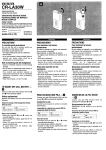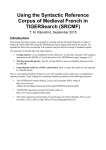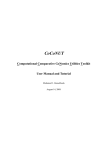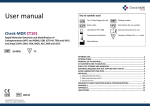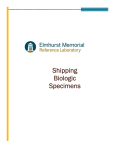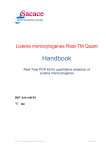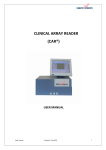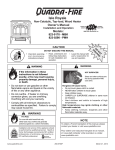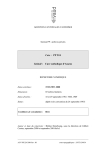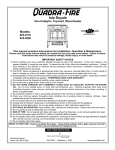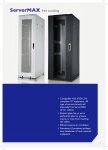Download Kit Manual - Alere Technologies GmbH
Transcript
Manual ChlamType-23S AS-4 Kit For the identification of Chlamydia species and other Chlamydiales 23S based Array Hybridisation Kit Kit order number: 246500096 96 reactions (ArrayStrip format) For Research Use Only. Not Intended for Use in Clinical Diagnostics. www.alere-technologies.com CONTENT BACKGROUND ................................................................................................................................. 1 GENERAL INSTRUCTIONS FOR USE .................................................................................................. 2 Intended Use .............................................................................................................................. 2 Specifications .............................................................................................................................. 2 Technical Support ....................................................................................................................... 2 Safety Precautions ...................................................................................................................... 3 Material Safety Data Sheets (MSDS) .......................................................................................... 3 Shipping Precautions .................................................................................................................. 3 REAGENTS AND DEVICES ................................................................................................................. 4 Kit Components, Storage and Stability ....................................................................................... 4 Suggested Reagents for DNA Labelling and Amplification (Recommended but not included.) .................................................................................................................................................. 4 Suggested Reagents for DNA Labelling and Amplification (Included) ..................................... 4 Suggested Reagents for Hybridisation and Detection (Included) ............................................ 5 Instrumentation & Software .................................................................................................... 6 Components Required but Not Provided ................................................................................. 6 AMPLIFICATION AND INTERNAL BIOTIN LABELLING ....................................................................... 8 Hybridisation .............................................................................................................................. 9 General Remarks for the Handling of Arrays............................................................................ 9 General Remarks for the Handling of Liquids......................................................................... 10 General Remarks - The Substrate (Precipitating Dye) D1 ...................................................... 11 General Remarks - Thermoshakers ........................................................................................ 11 Protocol for Quantifoil’s BioShake iQ ..................................................................................... 12 Protocol for Eppendorf’s Thermomixer Comfort with Microtiter Plate Adapter .................. 14 Data Analysis............................................................................................................................. 16 Starting the ArrayMate Reader .............................................................................................. 16 Worklist................................................................................................................................... 16 Data Acquisition in the ArrayMate Reader ............................................................................ 18 Results..................................................................................................................................... 20 Export of ChlamType-23S AS-4 Kit Test Report ...................................................................... 23 TROUBLESHOOTING AND REPORT INTERPRETATION ................................................................... 25 Staining Control ........................................................................................................................ 25 Negative Control ....................................................................................................................... 26 Marker rrl_0101_0177_10 ....................................................................................................... 26 Plausibility Controls .................................................................................................................. 26 Internal Amplification and Hybridisation Control EGFP ......................................................... 26 Family and Genus Control ...................................................................................................... 27 Mixed Infection Control.......................................................................................................... 27 Image Quality............................................................................................................................ 29 DNA Quality and RNA Contamination Control ......................................................................... 29 Physical Damage to the Array .................................................................................................. 29 Report Unavailable ................................................................................................................... 29 ADDITIONAL INFORMATION ......................................................................................................... 30 Warranty ................................................................................................................................... 30 ChlamType-23S AS-4 Kit 05_16_04_0011_V01_ChlamType-23S AS-4 Kit www.alere-technologies.com Disclaimer ................................................................................................................................. 30 Quality Control ......................................................................................................................... 30 List of Components for Separate Order ................................................................................... 31 Legal Manufacturer .................................................................................................................. 31 Contact...................................................................................................................................... 31 LITERATURE ................................................................................................................................... 32 UPDATES & SOFTWARE ................................................................................................................. 32 APPENDIX 1 – FLOW CHARTS ........................................................................................................ 33 APPENDIX 2 – PROBE TO TARGET TABLE ...................................................................................... 35 APPENDIX 3 – LIST OF REFERENCE EXPERIMENTS FOR PATTERN MATCH.................................... 36 APPENDIX 4 – HTML REPORT OF THE REFERENCE ISOLATE DC.38 TRACHOMATIS ...................... 37 ChlamType-23S AS-4 Kit 05_16_04_0011_V01_ChlamType-23S AS-4 Kit www.alere-technologies.com BACKGROUND The ALERE ChlamType-23S AS-4 Kit allows the rapid, economic and standardised DNA-based detection of all currently recognised Chlamydia species and other Chlamydiales. Extracted DNA from different possible sources is exponentially amplified in a specific PCR with 5´-Biotinlabelled primers. The resulting biotin-labelled dsDNA is transferred and hybridised to DNA microarrays with 57 oligonucleotide probes for different genetic markers plus essential controls. All of them are spotted three times. Based on a digital image of the arrays, spot recognition is performed automatically and results are provided as a html-file providing species identification. Two different methods for species discrimination were used: 1. Pattern Match: Comparison of an obtained hybridisation pattern with a set of 94 different theoretical and 14 experimental reference experiment patterns and subsequent assignment resulting in the best three matches. (See page 35). 2. Chlamydia Species Assignment after Signal Interpretation: Discrimination of Chlamydia species and other Chlamydiales using single markers and marker combinations. Controls: - staining controls using biotinylated control spots - negative control spots - internal amplification and hybridisation controls: o DNA template for internal amplification reaction (target EGFP) o Marker indicating E. coli DNA contamination in the amplification reaction Family and Genus markers Chlamydia species: - C. abortus - C. caviae - C. felis - C. psittaci ChlamType-23S AS-4 Kit 05_16_04_0011_V01_ChlamType-23S AS-4 Kit 1 www.alere-technologies.com C. pecorum C. pneumonia C. suis C. muridarum C. trachomatis C. avium C. gallinacea Other Chlamydiales: - Simkania - Waddlia - Protochlamydia amoebophila - Protochlamydia aegleriophila - Neochlamydia artmannellae ChlamType-23S AS-4 Kit 05_16_04_0011_V01_ChlamType-23S AS-4 Kit - Parachlamydia acanthamoebae Criblamydia sequanensis Chlamydiales Xenoturbella Estrella lausannensis 2 www.alere-technologies.com GENERAL INSTRUCTIONS FOR USE Intended Use For Research Use Only. Not for Use in Diagnostic Procedures. This assay allows the characterisation of amplified and labelled DNA originating from samples containing Chlamydia species and other Chlamydiales. The assay is made for research use and epidemiological applications. It should not be applied to other targets than Chlamydia and Chlamydiales. Specifications Upon receipt, the assay components need to be stored at different temperatures as specified in the package insert. The assay has to be performed at an ambient temperature of 18 °C to 28 °C. Technical Support If you require any further information on this product please contact: Email: [email protected] Phone: +49 (0) 36 41 3111-0 Fax: + 49 (0) 36 41 3111-120 For up-to-date information regarding the kit, please visit our website http://www.alere-technologies.com ChlamType-23S AS-4 Kit 05_16_04_0011_V01_ChlamType-23S AS-4 Kit 2 www.alere-technologies.com Safety Precautions The assay is intended for use by personnel trained in microbiological and molecular methods. Preparation of DNA from Chlamydia requires expertise in microbiology/molecular biology, and the local regulations for handling pathogenic microorganisms (biosafety level 2, avian C. psittaci biosafety level 3) are to be obeyed. Extracted chlamydial DNA from the different sources may be processed without further biosafety precautions, although contamination needs to be ruled out. Always wear protective clothing as required for laboratory work according to your specific regulations on laboratory safety. Material Safety Data Sheets (MSDS) According to OSHA 29CFR1910.1200, Commonwealth of Australia [NOHSC: 1005, 1008(1999)] and the latest amendments to the European Union Directives 67/548/EC and 1999/45/EC, the enclosed reagents do not require a Material Safety Data Sheet (MSDS). They do not contain more than 1 % of a component classified as hazardous and do not contain more than 0.1 % of a component classified as carcinogenic. Therefore, MSDS are not provided. Nevertheless, the buffers may cause irritation if they come into contact with eyes or skin, and may cause harm if swallowed. The regular precautions associated with laboratory work should be obeyed (e.g., wear protective goggles, gloves and lab coat and avoid contact with the reagents). If liquids have been spilled, clean with a disinfectant and/or laboratory detergent and water. Alere assumes no liability for damage resulting from the handling of or contact with these products. If you have any questions, please contact our Technical Support (see above). Shipping Precautions RID/ADR: Kein Gefahrgut / No dangerous goods IMDG: No dangerous goods IATA: No dangerous goods ChlamType-23S AS-4 Kit 05_16_04_0011_V01_ChlamType-23S AS-4 Kit 3 www.alere-technologies.com REAGENTS AND DEVICES Kit Components, Storage and Stability All reagents are provided in surplus (see below). If necessary, all components may be ordered separately. Please refer to the catalogue reference numbers (Cat#) at page 32 of this manual. For pricing please contact your local representative or our customer service, respectively. The expiry date can be found on each bottle and on the outer packaging. All components have been stability tested for short term shipment (< 1 week) at ambient temperature (< 37 °C). The assay components with limited stability are D1 and C3. The other kit components have been proven to be stable for six months after expiry. Suggested Reagents for DNA Labelling and Amplification (Recommended but not included.) Taq Polymerase S (5 U/µl), 10x Amplification buffer and 25 mM MgCl2: Genaxxon Taq Polymerase S (high specificity) , Genaxxon BioScience GmbH (http://www.genaxxon.de) Cat# M3001.0500 dNTPs, 10 mM each: Genaxxon PCR dNTP-Mix (Na salt), Genaxxon BioScience GmbH (http://www.genaxxon.de ) Cat# M3016.1010 Double distilled (dd) water INTYPE IC-DNA QIAGEN Leipzig GmbH, Cat# 05-902/1 (http://www.lab-leipzig.de) as EGFP template (2 x 105 copies/μl) Suggested Reagents for DNA Labelling and Amplification (Included) 23S_Forward Primer (100 µM): Forward primer, Metabion, 5´-ATTGAMAGGCGAWGAAGGA-3´ 23S_Reverse Primer_BIOTIN (100 µM): Reverse primer, Metabion, 5´Bio-GCYTACTAAGATGTTTCAGTTC-3´ Target gene: Chlamydia 23S rRNA, Amplicon: 171 bp EGFP_Forward Primer (10 µM): Forward primer (for internal amplification and hybridisation control), Metabion, 5´-CAGCCACAACGTCTATATCATG-3´ EGFP_Reverse Primer_BIOTIN (10 µM): Reverse primer, (for internal amplification and hybridisation control) Metabion, 5´Bio-CTTGTACAGCTCGTCCATGC-3´ ChlamType-23S AS-4 Kit 05_16_04_0011_V01_ChlamType-23S AS-4 Kit 4 www.alere-technologies.com Target gene: Internal control, Amplicon: 276 bp Suggested Reagents for Hybridisation and Detection (Included) ArrayStrips (12 x 8 samples), Protected against light and sealed under inert gas. Store at 18 °C to 28 °C. To be used within two weeks after opening. Close the unused wells with caps to protect them against humidity and dust and store them in the dark. Avoid any touching or scratching of the microarray surface at the bottom of the well. Do not store or handle unused wells at an air humidity of more than 60 % since this may irreversibly corrode the spots. StripCaps (24 strips) C1: Hybridisation Buffer Store at 18-28 °C, protect against sunlight. Surplus: 200 %. C2: Washing Buffer 1 Store at 18 °C - 28 °C, protect against direct sunlight. Surplus: 200 %. C3: HRP Conjugate 100 x Store at 2-8 °C, protect against direct sunlight. Surplus: 100 %. C4: Conjugate Buffer Store at 18 °C to 28 °C, protect against direct sunlight. Surplus: 200 %. C5: Washing Buffer 2 Store at 18 °C to 28 °C, protect against direct sunlight. Surplus: 500 %. D1: Horseradish Peroxidase Substrate Store at 2-8 °C, protect against direct sunlight. Surplus: 50 %. ChlamType-23S AS-4 Kit 05_16_04_0011_V01_ChlamType-23S AS-4 Kit 5 www.alere-technologies.com Instrumentation & Software ArrayMate Reader (to be ordered separately, for details see below) The ArrayStrip based ChlamType-23S AS-4 Kit can be processed on the ArrayMate reader only. Alternative devices ATR01/03 are not suitable for reading ArrayStrips. If you have questions, please contact us. Iconoclust software (provided with the reader) Test-specific software plug-in (can be downloaded from Alere Technologies website, check periodically for updates, for details see below). Specific information, such as spot names, marker names, location of the spots on the array, and size of the image taken by the reader’s camera, is delivered with the reader or can be downloaded from our website. These test-specific plug-ins will be updated occasionally. Please check the NEWS section of our website www.alere-technologies.com. Support is available via [email protected]. Components Required but Not Provided DNA preparation kits: The assay has been tested using the DNeasy Blood & Tissue Kit by Qiagen (Cat# 69504) and the High Pure PCR Template Preparation Kit from Roche (Cat# 11796828001). Kits from other suppliers can be used if validated for the assay. Please note: The DNA specimen needs to be sufficient in quality for PCR reactions. Equipment for DNA isolation, e.g. pipettes, centrifuge, thermoshaker, or automated device Photometer (OD 260 nm) for measuring the DNA concentration Equipment for non-denaturing agarose DNA gel electrophoresis for quality control of DNA Thermocycler for PCR Thermoshaker for hybridisation Please note: We strongly recommend the BioShake iQ by QInstruments (http://www.qinstruments.com/) equipped with a customised heating block designed to fit ArrayStrips. Alternatively, you may use Eppendorf’s Thermomixer Comfort equipped with a heating block for microtiter plates. ChlamType-23S AS-4 Kit 05_16_04_0011_V01_ChlamType-23S AS-4 Kit 6 www.alere-technologies.com Pipettes: Suitable for 1 µl-5 µl volumes, 90 µl, 100 µl, 200 µl, and 1000 µl Multichannel pipettes for 100-200 µl Sterile reaction vials suitable for PCR (VWR Cat# 732-0098). Ultrapure (PCR grade) water Pasteur pipettes (VWR Cat# 612-2856). ChlamType-23S AS-4 Kit 05_16_04_0011_V01_ChlamType-23S AS-4 Kit 7 www.alere-technologies.com AMPLIFICATION AND INTERNAL BIOTIN LABELLING We provide all primers. All other recommended components should be purchased from a supplier of your choice. EGFP_Forward Primer, EGFP_Reverse Primer_BIOTIN and INTYPE IC-DNA are necessary if you use the Internal Amplification and Hybridisation Control EGFP. If you don’t use the control, please ignore the error message on the report page 1. If you use field samples or other samples with very low initial DNA concentrations, please make sure to run the PCR amplification reactions in two single runs (instead of running them as duplex PCR), combine the 2 PCR reactions afterwards, and hybridize them against one and the same microarray. We recommend including external amplification controls that contain DNA of Chlamydia reference strains as positive control and in addition, double distilled water as negative control. Prepare a master mix by combining the following components per sample: 23s_PCR 1. water 2. buffer 3. MgCl2 4. dNTP Mix 5. Primer P1 6. Primer P2 7. Primer P3 8. Primer P4 9. Polymerase 10. EGFP-Template Components double distilled water 10x Genaxxon Amplification Buffer 25 mM MgCl2 Genaxxon dNTPs, 10 mM each Genaxxon 23S_Forward Primer (100 µM) 23S_Reverse Primer_BIOTIN (100 µM) EGFP_Forward Primer (10 µM)* EGFP_Reverse Primer_BIOTIN (10 µM)* Genaxxon Taq Polymerase S (high specificity), 5U/µl INTYPE IC-DNA (2 x 105 copies/µl)* Volume in µl 13.8 2.0 1.2 0.4 0.1 0.1 0.1 0.1 0.2 1.0 Final concentration 1x 1.5 mM 0.2 mM 500 nM 500 nM 50 nM 50 nM 1U 1x104 copies/µl *Replace with dd water if you don’t use the control Add 1 µl of Chlamydia DNA to 19 µl of the master mix. Do not forget to label the vial properly. Conduct amplification in a programmed thermocycler (e.g., Eppendorf Mastercycler gradient with heated lid) according to the following temperature-time profile: ChlamType-23S AS-4 Kit 05_16_04_0011_V01_ChlamType-23S AS-4 Kit 8 www.alere-technologies.com Pre-heat cover/lid to 105 °C 60 sec at 96 °C 30 sec at 94 °C 40 cycles with 30 sec at 60 °C 30 sec at 72 °C 240 sec at 72 °C Cool down to 4 °C, hold The samples can be stored at – 20° C until use. Please note: When using another thermocycler, minor adaptations to the program might be necessary. Proper validation involving reference samples and controls is indispensable before routine use of the assay. Hybridisation General Remarks for the Handling of Arrays Never touch the array surface. Avoid complete drying of the array surface during processing. Do not allow the array to stay without liquid for more than two minutes. Never rinse the wells with distilled water after the hybridisation step, only use C2 Washing Buffer. Unused wells should remain capped during the whole procedure. The strips may be processed up to three times without loss of quality of properly capped unused arrays. Close all wells that will not be used with a cap and leave them there until use (for storage conditions after use: see section ‘Kit components, storage and stability/Hybridisation and Detection”). Always label your array strips with a laboratory marker at the recommended position. Never label them on the bottom or across the data matrix barcode. This may cause errors. ChlamType-23S AS-4 Kit 05_16_04_0011_V01_ChlamType-23S AS-4 Kit 9 www.alere-technologies.com Avoid contact of data matrix barcode with organic solvents. The ArrayMate needs the information encoded in the data matrix to perform the assay and the analysis afterwards. Avoid touching the bottom of the microarray strip and keep it clean. General Remarks for the Handling of Liquids We recommend the use of a multichannel pipette and reagent reservoirs. We strongly recommend that the liquid is removed by pipetting rather than inverting the strips and pouring the liquids out. Disposable fine-tipped soft Pasteur pipettes (such as VWR / Cat# 612-2856) are suited best. Always place the pipette tip at the space between the array and the wall of the reagent well. If you touch the array surface, probes may be scratched off, and this may cause errors. ChlamType-23S AS-4 Kit 05_16_04_0011_V01_ChlamType-23S AS-4 Kit 10 www.alere-technologies.com Pipette tip Use the space between the array and the wall of the tube. Do never touch the array. Array General Remarks - The Substrate (Precipitating Dye) D1 An appropriate amount of D1 substrate (precipitating dye) should be transferred into an Eppendorf tube and taken out of the refrigerator when starting the procedure to allow it to pre-warm to room temperature (25 °C). Cold D1 may yield weak signals. D1 should be centrifuged prior to use to remove bubbles as well as possible precipitates (quick spin). Triggered by peroxidase, in the case of positive reactions, the dye precipitates but it is not covalently bound. The precipitate can be dissolved by vigorous shaking. Thus the arrays must not be shaken, dropped or moved abruptly during the staining procedure or thereafter. After completion of staining, remove and discard reagent D1 as completely as possible and scan immediately. The dye precipitate fades slowly in presence of liquids. General Remarks - Thermoshakers The correct temperature within the vessels is essential; therefore always use the appropriate equipment for heating. Because of the possibility of inhomogeneous temperature distribution within the heating block, as well as possible differences between displayed and actual temperatures, the use of different brands of thermoshakers might affect test performance. We tested the assay with a BioShake iQ by QInstruments (http://www.qinstruments.com/) equipped with a customised heating block designed to fit ArrayStrips, as well as with an Eppendorf Thermomixer Comfort (http://www.eppendorf.com/), equipped with a heating block for microtiter plates and Deepwell plates (Eppendorf, Cat# 5363000012). When using ChlamType-23S AS-4 Kit 05_16_04_0011_V01_ChlamType-23S AS-4 Kit 11 www.alere-technologies.com other devices, some modifications to the protocol might be necessary. Before starting routine use, please test the protocol with a few known reference strains. The only difference between the protocols for QInstruments BioShake iQ and Eppendorf’s Thermomixer Comfort with Microtiter Plate Adapter is the washing temperature after the hybridisation step. Protocol for Quantifoil’s BioShake iQ BioShake iQ by QInstruments equipped with a customised heating block designed to fit ArrayStrips. Preparation of the hybridisation mixture (denaturation): Pipette 98 µl of C1 buffer into a 1.5 ml tube and add 2 µl labelled duplex amplification product (or 2 x 1 µl amplification product in case of two single runs), close the tube and mix gently. Incubate the mixture at 95 °C for 5 min (in a water bath or in a thermoshaker). Cool down the tube on ice for 2 min. Pre-washing the arrays: Switch on the thermoshaker and let it pre-heat to 58 °C. Remove the ArrayStrip(s) from the pouch. Insert the ArrayStrip(s) into the white frame. Make sure the orientation is correct (data matrix barcode close to row (A) and the strips fit properly. Pre-wash the array(s) with 200 µl PCR-grade distilled water per well: pipette the water 4 times up and down at room temperature. Remove the water from the well. ChlamType-23S AS-4 Kit 05_16_04_0011_V01_ChlamType-23S AS-4 Kit 12 www.alere-technologies.com Transfer the denaturated amplification product (100 µl) to one well of the prepared strip. Incubate at 58 °C and 550 rpm for 60 min. Meanwhile, login to the ArrayMate device and prepare your worklist (see ‘Data Analysis’ section, p. 18) Remove the liquid and add 200 µl C2 Washing Buffer. Incubate at 43 °C and 550 rpm for 10 min, remove and discard. Add another 200 µl C2 Washing Buffer. Incubate at 43 °C and 550 rpm for 10 min. Meanwhile, prepare conjugate: For each experiment add 1 µl 100x HRP conjugate to 100 µl C4 Conjugation Buffer. This mixture is stable at room temperature for around one working day; C3 is delivered with a surplus of 100 %, and C4 with a surplus of 200 %. Suggested pipetting scheme: C3 C4 1 well 1.5 µl 150 µl 2-3 wells 3.5 µl 350 µl 4-6 wells 7 µl 700 µl 7-10 wells 11 µl 1100 µl 11-15 wells 16 µl 1600 µl 16-20 wells 21 µl 2100 µl 21-30 wells 32 µl 3200 µl 31-40 wells 42 µl 4200 µl Remove the Washing Buffer, and add 100 µl diluted conjugate to each well, incubate at 30 °C and 550 rpm for 10 min. Remove the conjugate, add 200 µl C5 Washing Buffer. Pipette the buffer 4 times up and down at room temperature. Remove the Washing Buffer, add 100 µl of D1 substrate (precipitating dye, at 25 °C, see above) per well. Incubate at 25 °C for 5 min but do not shake! Remove liquid completely. The bottom of the ArrayStrips (outside surface) may be cleaned carefully with wipes. Bubbles may be removed by removing and adding D1. Scan and process (see below). ChlamType-23S AS-4 Kit 05_16_04_0011_V01_ChlamType-23S AS-4 Kit 13 www.alere-technologies.com Protocol for Eppendorf’s Thermomixer Comfort with Microtiter Plate Adapter Eppendorf Thermomixer with thermoblock for MTPs and deepwell plates. Preparation of the hybridisation mixture (denaturation): Pipette 98 µl of C1 buffer into a 1.5 ml tube and add 2 µl labelled duplex amplification product (or 2 x 1 µl amplification product in case of two single runs). Close the tube and mix gently. Incubate the mixture at 95 °C for 5 min (in a water bath or in a thermocycler). Cool down the tube on ice for 2 min. Pre-washing the arrays: Switch on the thermoshaker and let it pre-heat to 58 °C. Remove the ArrayStrip(s) from the pouch. Insert the ArrayStrip(s) into the white frame. Make sure the orientation is correct (data matrix barcode close to row (A) and the strips fit properly. Pre-wash the array(s) with 200 µl PCR-grade distilled water per well: pipette the water 4 times up and down at room temperature. Remove the water from the well. Transfer the denaturated amplification product (100 µl) to one well of the prepared strip. Incubate at 58 °C and 550 rpm for 60 min. Meanwhile, login to the ArrayMate device and prepare your worklist (see ‘Data Analysis’ section p. 18) Remove the liquid and add 200 µl C2 Washing Buffer. Incubate at 50 °C and 550 rpm for 10 min, remove and discard. ChlamType-23S AS-4 Kit 05_16_04_0011_V01_ChlamType-23S AS-4 Kit 14 www.alere-technologies.com Add another 200 µl C2 Washing Buffer. Incubate at 50 °C and 550 rpm for 10 min. Meanwhile, prepare conjugate: For each experiment add 1 µl 100x HRP conjugate to 100 µl C4 Conjugation Buffer. This mixture is stable at room temperature for around one working day; C3 is delivered with a surplus of 100 %, and C4 with a surplus of 200 %. Suggested pipetting scheme: C3 C4 1 well 1.5 µl 150 µl 2-3 wells 3.5 µl 350 µl 4-6 wells 7 µl 700 µl 7-10 wells 11 µl 1100 µl 11-15 wells 16 µl 1600 µl 16-20 wells 21 µl 2100 µl 21-30 wells 32 µl 3200 µl 31-40 wells 42 µl 4200 µl Remove the Washing Buffer, and add 100 µl diluted conjugate to each well, incubate at 30 °C and 550 rpm for 10 min. Remove the conjugate, add 200 µl C5 Washing Buffer. Pipette the buffer 4 times up and down at room temperature. Remove the Washing Buffer, add 100 µl of D1 substrate (precipitating dye, at 25 °C, see above) per well. Incubate at 25 °C for 5 min but do not shake! Remove liquid completely. The bottom of the ArrayStrips (outside surface) may be cleaned carefully with wipes. Bubbles may be removed by removing and adding D1. Scan and process (see below). ChlamType-23S AS-4 Kit 05_16_04_0011_V01_ChlamType-23S AS-4 Kit 15 www.alere-technologies.com Data Analysis Starting the ArrayMate Reader We recommend launching the ArrayMate Reader after starting the hybridisation; this allows the worklist file to be imported prior to the beginning of manual operations. Please note that this is a short instruction only. For more detailed information please refer to the ArrayMate User Manual. Switch on the ArrayMate (1st: Main switch on the rear below the electric cable plug, 2 nd: Operating switch on the lower left corner of the front side). Switch on the screen (switch is on the right hand side below the screen). Log-in as R&D User (Research and Development User) for full access to test-specific software (default password: abcde). If you log-in as User, you will obtain raw values, but neither positives/negatives interpretation nor strain assignment. The Administrator log-in (default password: 12345) will allow the installation of a new assay specific plug-in, which can be downloaded at http://alere-technologies.com. The user interface will be loaded, the ArrayMate performs internal testing. This requires slightly less than a minute. Click New Run (left edge of the screen). A suggestion for a run name/folder name for the new run appears in the top line of the screen. You may modify or change the experiment name at your convenience. Type in your operator ID (optional). Worklist A Worklist file allows an identifier, such as a laboratory or sample number, to be linked to the respective array position on the ArrayStrip. For privacy reasons, arrays or the respective experiments should not be denoted with patient names. Worklists can be generated using spreadsheet software such as EXCEL (see below), but must be saved in the *.txt file format, which can be imported into the test-specific ArrayMate software. Do not include special characters (such as : ; ()[] / \ ä ü etc.). ChlamType-23S AS-4 Kit 05_16_04_0011_V01_ChlamType-23S AS-4 Kit 16 www.alere-technologies.com Create a list with at least three columns having headers written in the first line. The following headers are obligatory (in this order): position / sampleID / assayID (Table 1). Positions are consecutively numbered from 1 to a maximum of 96. Position 1 would correspond to A1, 8 to H1, 9 to A2 and 96 to H12 (Table 2). Do not leave empty lines in the worklist. If you use EXCEL, position numbers should be entered into column A. Sample IDs are strain/sample/laboratory numbers, e.g. as exported from your LIMS (or designated in any different way). Patient names should not be used as sample IDs. The Assay ID allows the system to identify the current test and to correctly use information on layout, spot number and identity etc. The ChlamType-23S AS-4 Kit has the Assay ID: 10454. Please note: When entering assay IDs manually, make sure to enter the correct number as this could lead to errors or loss of data. You may add further columns and headers with notes and comments at your convenience. Information from these columns will neither appear on the result screen nor in the Test Report. We recommend the use of a printout of the worklist as a template for pipetting. Save the worklist as tab separated *.txt file on the memory stick provided together with the ArrayMate. To avoid confusion, make sure that worklists are named unambiguously, or that worklists from earlier experiments are deleted. You may use the software tool Worklist Generator to create a Worklist easily. http://alere-technologies.com/en/products/lab-solutions/software-tools/worklistgenerator.html ChlamType-23S AS-4 Kit 05_16_04_0011_V01_ChlamType-23S AS-4 Kit 17 www.alere-technologies.com Table 1: Worklist example Please note: Table head must be written exactly as shown. position 1 2 3 4 5 6 7 8 SampleID 2014-12345 2014-12346 2014-12347 2014-12348 2014-12349 2014-12350 DC48_Simkania C. caviae assayID 010454 010454 010454 010454 010454 010454 010454 010454 assayType 23s 23s 23s 23s 23s 23s 23s 23s Table 2: Positions in the 96 well format 1 1 2 3 4 5 6 7 8 A B C D E H G H 2 9 10 11 12 13 14 15 16 3 17 18 19 20 21 22 23 24 4 25 26 27 28 29 30 31 32 5 33 34 35 36 37 38 39 40 6 41 42 43 44 45 46 47 48 7 49 50 51 52 53 54 55 56 8 57 58 59 60 61 62 63 64 9 65 66 67 68 69 70 71 72 10 73 74 75 76 77 78 79 80 11 81 82 83 84 85 86 87 88 12 89 90 91 92 93 94 95 96 Data Acquisition in the ArrayMate Reader Insert your flash drive containing the worklist into any of the USB ports on the lower righthand side of the ArrayMate. Press Select your worklist (path: ‘My Computer/Removable Disk’). Open your selected worklist by pressing Enter or Open. Press ; a folder selection dialogue will open. (your imported worklist opens in a separate window). Proofread. If the new window is empty, or if it was the wrong worklist, repeat the import. Press OK; the worklist window will close. ChlamType-23S AS-4 Kit 05_16_04_0011_V01_ChlamType-23S AS-4 Kit 18 www.alere-technologies.com Leave the flash drive in the ArrayMate if you intend to export ChlamType-23S AS-4 Kit reports afterwards (Check the flash drive regularly for computer viruses and malware using an appropriate program.). Press Next (at the bottom right on the screen; reader is opening). Carefully insert the appropriate metallic adapter/frame into the ArrayMate. Do not apply strong force. Ensure proper fit, otherwise the images may be out of focus. Carefully insert the white frame with the array strips into the metallic adapter. Ensure the correct orientation (Position A1 in the frame next to the data matrix barcode on the adapter) and proper fit; otherwise the images may be out of focus. ArrayStrip frame with inserted strips. Strips are inserted in accordance with the Worklist. Please note: ArrayStrips must be clean. They should not contain any liquids during analysis. Data matrix codes must be clean. There must be no Array StripCaps on the wells to be analysed (however, unused wells should remain capped). Press Next (at the bottom right on the screen; reader closes, analysis program starts, it takes about 2-10 min, depending on the number of strips; the reader takes images and automatically analyses the data). The progress of the reading is indicated by the following symbols: photographed: in analysis: ready: The reader indicates the end of the entire process with an acoustic signal (beep). Press Next (at the bottom right on the screen; reader is opening). Remove the white frame with the ArrayStrip(s). Press Next (at the bottom right on the screen; reader is closing). ChlamType-23S AS-4 Kit 05_16_04_0011_V01_ChlamType-23S AS-4 Kit 19 www.alere-technologies.com Results On the left-hand side of the screen, there you will see a list showing all runs stored on the ArrayMate´s hard disk. A run contains the results from all arrays analysed together within one frame. If this list is not displayed: Press Archive (left hand side) and activate the flag Browse (at the top left). The runs are organised like folders in Windows Explorer, and named by default according to the date of acquisition. Example: There is one experiment run in this archive: If you click on the plus symbol left to the run name, the folder opens and you will see a list of the individual arrays alphabetically ordered by Sample ID. ChlamType-23S AS-4 Kit 05_16_04_0011_V01_ChlamType-23S AS-4 Kit 20 www.alere-technologies.com Click on a Sample ID and the ChlamType-23S AS-4 Kit test report (flag results) for this array is shown in the window on the right: Click on flag resultsB and the Test Report B is shown in the window on the right: Click on flag raw data and the raw data is shown in the window on the right: ChlamType-23S AS-4 Kit 05_16_04_0011_V01_ChlamType-23S AS-4 Kit 21 www.alere-technologies.com Click on flag segmentation image and the grid alignment accuracy is shown in the window on the right: Click on flag image and the image file (*.bmp) is shown in the window on the right: ChlamType-23S AS-4 Kit 05_16_04_0011_V01_ChlamType-23S AS-4 Kit 22 www.alere-technologies.com This image of the reference isolate C. trachomatis shows an example for a valid test without any dust particles or non-specific background. The image file is automatically analysed be the ArrayMate software and a HTML report is provided that lists all markers that have been analysed. Export of ChlamType-23S AS-4 Kit Test Report The generated result files in an html format will show information of all target genes. Possible invalid controls that might display in this report will be explained below (see Troubleshooting). Other files that are generated and that can be exported include A *.txt file with the raw measurements, An image file (*.bmp) with the actual photo of the array, A second image file (*.png) in which the coordinate grid is superimposed and the recognised spots are circled, and A XML (*.xml) files that contains the same information as the html result sheets for future export into databases etc. ChlamType-23S AS-4 Kit 05_16_04_0011_V01_ChlamType-23S AS-4 Kit 23 www.alere-technologies.com Please note: Only complete runs can be exported. The export of individual ChlamType-23S AS4 Kit Test Reports is not possible. Right-click on the selected run (a menu appears with the option Export Run Reports). Right-click on Export Run Reports (a file browser opens). Click My Computer, then Removable Disk and choose the folder where to save or click Make New Folder (on the bottom, a new folder icon appears). Rename the new folder (e.g. with the experiment name or date). Click Ok (data are exported into the new folder on your flash drive). Do NOT remove the flash drive as long as the hourglass symbol is visible. Switch off the device by clicking Power (at the bottom left on the screen): Switch off the screen. There is no need to physically switch off the ArrayMate Reader. ChlamType-23S AS-4 Kit 05_16_04_0011_V01_ChlamType-23S AS-4 Kit 24 www.alere-technologies.com TROUBLESHOOTING AND REPORT INTERPRETATION In case of any troubleshooting make sure that reagents are within the recommended shelf-life and stored appropriately. In case of problems we are always happy to provide support. Please e-mail to [email protected] and include a description of the problem, as well as the array images (*.bmp files) in question. Two different methods for species discrimination were used: 1. Pattern Match: Comparison of an obtained hybridisation pattern with a set of 94 different theoretical and 14 experimental reference experiment patterns and subsequent assignment resulting in the best three matches. (See page 38). The pattern match algorithm provides an initial orientation and is not fully reliable in closely related patterns. Each theoretical reference pattern exists in 3 different variants (assuming high, medium and low stringency hybridisation conditions). 2. Chlamydia Species Assignment after Signal Interpretation: Discrimination of Chlamydia species and other Chlamydiales using single markers and marker combinations. This method might provide more accuracy, if the pattern match is not applicable. If both results are not in concordance, please stay with the result of the Chlamydia Species Assignment after Signal Interpretation. Staining Control A staining control is included to check whether possible problems originate from the hybridisation or the staining procedure. If the staining control has ‘Failed’ proceed as follows: Horseradish peroxidase conjugate may have degraded during storage. Add 1 µl C3/C4 buffer to 9 µl D1 (substrate). If the solution turns green within 3-5 seconds, the horseradish peroxidase still has sufficient enzymatic activity. ChlamType-23S AS-4 Kit 05_16_04_0011_V01_ChlamType-23S AS-4 Kit 25 www.alere-technologies.com Enzymatic reaction is inhibited by carryover of buffer C1. Ensure proper washing of the wells with C2 buffer to remove all C1 buffer prior to adding horseradish peroxidase conjugate. Negative Control ‘Failed’ indicates possible problems originating from the staining procedure. Marker rrl_0101_0177_10 Marker indicates E. coli DNA contamination. The presence of E. coli DNA (e.g. originating from the DNA polymerase production process) can reduce the signal intensity of other spots and hence yield false negative results. One can ignore this marker if the species identification is okay. Plausibility Controls The following error messages (Plausibility Controls) might appear in the report: Internal Amplification and Hybridisation Control EGFP At least one of three EGFP probes has to be positive. Otherwise an error message is shown: Plausibility Controls control Internal Amplification and Hybridisation Control result Failed explanation Absence indicates inhibition of DNA amplification! Please repeat the experiment! A negative internal amplification and hybridisation control together with a negative species assignment might be due to potential inhibitors in your current DNA preparation. A positive internal amplification and hybridisation control together with a negative species assignment might be due to a very low input of DNA copy numbers or fragmentation of the ChlamType-23S AS-4 Kit 05_16_04_0011_V01_ChlamType-23S AS-4 Kit 26 www.alere-technologies.com DNA. Please repeat the amplification in two single tubes (not as duplex PCR) and hybridize it together in one and the same well. A negative internal amplification and hybridisation control together with a positive species assignment might by due to a very high DNA copy number input. The plausibility control can be ignored if you do not use INTYPE IC-DNA. Family and Genus Control If family or genus markers are too weak, negative or does not match, respectively, an error message appears: Plausibility Controls control result explanation Weak or implausible species marker. Species Control Please repeat the experiment! Failed Please note that other Chlamydiales will not generate family and genus signals (e.g.Simkania, Waddlia, Protochlamydia, Neochlamydia, Parachlamydia, Criblamydia, Chlamydiales or Estrella). Mixed Infection Control This error message appears if more than one species is found from chlamydia species assignment after signal interpretation, or if more than one genus marker (chlamydia and chlamydophila) is positive: Plausibility Controls control Mixed Infection Control result Positive explanation "Positive" indicates a mixed infection comprising two or more Chlamydia strains or DNA contamination. Special case: If the species C. caviae AND C. felis or C. pecorum AND C. abortus give a mixed hybridisation pattern, a special mixed infection control statement appears: ChlamType-23S AS-4 Kit 05_16_04_0011_V01_ChlamType-23S AS-4 Kit 27 www.alere-technologies.com Plausibility Controls control result explanation If all probes for C. caviae AND C. felis give a signal, there are two possibilities of interpretation: Mixed Infection Control Attention i) presence of C. caviae only, while the C. felis signals are due to crosshybridisation (if family marker pos_56_C is negative), ii) mixed infection of both species (in this case, family marker pos_56_C is positive; see page B). Or: Plausibility Controls control result explanation If all probes for C. pecorum AND C. abortus give a signal, there are two possibilities of interpretation: Mixed Infection Control Attention i) presence of C. pecorum only, while the C. abortus signals are due to crosshybridisation (if family marker pos_56_C is negative), ii) mixed infection of both species (in this case, family marker pos_56_C is positive; see page B). ChlamType-23S AS-4 Kit 05_16_04_0011_V01_ChlamType-23S AS-4 Kit 28 www.alere-technologies.com Image Quality In case of poor image quality, we recommend to re-check the labelled amplification product quantity and quality, first by loading the remaining PCR product on an agarose gel. In order to determine whether any problems originated from the DNA preparation, conduct an experiment with control material. DNA from a number of Chlamydia spp. reference and clinical strains can be obtained from the German Collection of Microorganisms and Cell Cultures (DSMZ; www.dsmz.de or other strain collections such as ATCC or Institute Pasteur). If the control experiment yields a valid result and a correct identification, there was probably an issue with DNA preparation. If the control experiment fails as well, an error in later steps or degradation of reagents from later steps is likely. DNA Quality and RNA Contamination Control The template DNA should be largely un-fragmented, as fragmentation reduces the amplification and labelling efficiency. For this reason DNA should not be prepared by using bead beaters, ultra-sonication or aggressive chemicals, such as those in alkaline lysis protocols. The present Assay has been validated using the QIAGEN DNeasy and the Roche High Pure kits. DNA should be free of any traces of ethanol, as ethanol inhibits the amplification. It is possible to heat the sample prior to adding it to the labelling mix (5-10 min at 70 °C) to evaporate the ethanol. Physical Damage to the Array Scratching the array surface with a pipette tip may damage array spots, which may lead to the impairment or absence of a valid signal. In this case, the respective marker will not be assigned as ‘negative’, but instead, the message ’none’ appears next to the marker name. Report Unavailable If the ArrayMate indicates that no report is available for an array (or multiple arrays on one strip), please check that the strip has been positioned properly in the frame. Scratches or drops of condensed water might render the barcode identifier unreadable, so please wipe it carefully or try to identify the test manually. If no obvious reason for the fault can be detected, please contact the technical service. ChlamType-23S AS-4 Kit 05_16_04_0011_V01_ChlamType-23S AS-4 Kit 29 www.alere-technologies.com ADDITIONAL INFORMATION Warranty Alere Technologies guarantees the performance as described in this user guide. The usage of the kit was successfully tested at ambient temperatures up to 37 °C. A guarantee is limited to ambient temperatures in the laboratory between 18 to 28 °C. Assay components comprise the arrays and their caps, the lysis enhancer, the reagents for DNA labelling and for detection of labelled DNA products on the array, the ArrayMate reader and its software. In case one of these components fails within the expiry date due to reasons other than misuse, contact Alere Technologies for replacement or refund. Terms and conditions apply. If you have any problem or question, please contact the technical service. Disclaimer This system is for research use only. We do not accept any liability for damages caused by misuse. That includes the use for diagnostic applications and for the guidance of therapy. We shall not be held liable for damages caused by an inappropriate use of the device as a personal computer, for instance related to the use of additional software, to network connections, or to a breach of privacy related to the storage of confidential information (such as names of patients) on its hard disk and/or to the use of external storage devices that might be contaminated with spyware. Quality Control Each batch is stringently tested for good performance and correctness of results. ChlamType-23S AS-4 Kit 05_16_04_0011_V01_ChlamType-23S AS-4 Kit 30 www.alere-technologies.com List of Components for Separate Order If required, these reagents for the ChlamType-23S AS-4 Kit may be ordered separately: component 23S_FP 23S_RP EGFP_FP EGFP_RP C1 C2 C3 C4 C5 D1 ArrayStrips StripCaps name 23S_Forward Primer (100 µM) 23S_Reverse Primer_BIOTIN (100 µM) EGFP_Forward Primer (10 µM) EGFP_Reverse Primer_BIOTIN (10 µM) Hybridisation Buffer Washing Buffer 1 HRP Conjugate 100 x Conjugate Buffer Washing Buffer 2 HRP Substrate Chlam AS-4 StripCaps category primer amount 20 µl primer 20 µl primer 20 µl primer 20 µl buffered reagent buffer buffered enzyme buffered reagent buffer buffered reagent plugged microarrays plastic ware 30 ml 120 ml 200 µl 30 ml 120 ml 15 ml 1 strip 1 strip Cat# 246503501 storage -20 °C -20 °C -20 °C 246503502 245105000 245106000 245107000 245108000 245109000 245110000 240010454 245112000 -20 °C 18-28 °C 18-28 °C 2-8 °C 18-28 °C 18-28 °C 2-8 °C 15-28 °C 15-28 °C For prices please contact us: Legal Manufacturer Alere Technologies GmbH Loebstedter Str. 103-105 07749 Jena, Germany Contact If you require any further information on this product please e-mail to [email protected] ChlamType-23S AS-4 Kit 05_16_04_0011_V01_ChlamType-23S AS-4 Kit 31 www.alere-technologies.com LITERATURE http://alere-technologies.com/en/products/lab-solutions/chlamydia.html UPDATES & SOFTWARE Notifications on database/software updates and freeware tools can be found at http://alere-technologies.com/en/science-technologies/publications/downloads.html. and/or http://alere-technologies.com/en/news.html. ChlamType-23S AS-4 Kit 05_16_04_0011_V01_ChlamType-23S AS-4 Kit 32 www.alere-technologies.com APPENDIX 1 – FLOW CHARTS The figures summarise the test procedure. However, please refer to the text section of this manual at any step of the test protocol for further important details. Protocol : Quantifoil BioShake iQ processing time handsontime 130 min 20 min 2 min 2 min 10 min 2 min 2 min 2 min hybridise; 58 °C, 550 rpm; 60 min Meanwhile: Login to the ArrayMate device and prepare your worklist. 60 min 10 min discard labeled DNA; incubate twice in 200 µl Buffer C2; 43 °C, 550 rpm, 10 min; prepare C3/C4-Conjugate (C3:C4=1:100), preheat Substrate D1 (25°C) 25 min 5 min discard Buffer C2; incubate in 100 µl C3/C4-Conjugate; 30 °C, 550 rpm, 10 min 15 min 3 min discard C3/C4-Conjugate; rinse with 200 µl Buffer C5; 4 x up and down 2 min 2 min discard Buffer C5; incubate with 100 µl Substrate D1; 25 °C, 5 min 10 min 2 min discard Substrate D1; analyse (ArrayMate) 10 min 5 min prepare ArrayStrips prepare DNA label genomic Chlamydia DNA in thermocycler 1 µl DNA plus MasterMix preparing labeled DNA to 98 µl of Buffer C1 add 2 µl of labeled DNA rinse ArrayStrips 200 µl water; 4 x up and down denaturation of labeled DNA 5 min, 95°C; 2 min cool down discard water transfer 100 µl labeled DNA to ArrayStrips Label here Barcode total time requirement : app. 4,5 h app. 1 h ChlamType-23S AS-4 Kit 05_16_04_0011_V01_ChlamType-23S AS-4 Kit 33 www.alere-technologies.com Protocol : Eppendorf Thermomixer processing time handsontime 130 min 20 min 2 min 2 min 10 min 2 min 2 min 2 min hybridise; 58 °C, 550 rpm; 60 min Meanwhile: Login to the ArrayMate device and prepare your worklist. 60 min 10 min discard labeled DNA; incubate twice in 200 µl Buffer C2; 50 °C, 550 rpm, 10 min; prepare C3/C4-Conjugate (C3:C4=1:100), preheat Substrate D1 (25°C) 25 min 5 min discard Buffer C2; incubate in 100 µl C3/C4-Conjugate; 30 °C, 550 rpm, 10 min 15 min 3 min discard C3/C4-Conjugate; rinse with 200 µl Buffer C5; 4 x up and down 2 min 2 min discard Buffer C5; incubate with 100 µl Substrate D1; 25 °C, 5 min 10 min 2 min discard Substrate D1; analyse (ArrayMate) 10 min 5 min prepare ArrayStrips prepare DNA label genomic Chlamydia DNA in thermocycler 1 µl DNA plus MasterMix preparing labeled DNA to 98 µl of Buffer C1 add 2 µl of labeled DNA rinse ArrayStrips 200 µl water; 4 x up and down denaturation of labeled DNA 5 min, 95°C; 2 min cool down discard water transfer 100 µl labeled DNA to ArrayStrips Barcode Label here total time requirement : app. 4,5 h app. 1 h ChlamType-23S AS-4 Kit 05_16_04_0011_V01_ChlamType-23S AS-4 Kit 34 www.alere-technologies.com APPENDIX 2 – PROBE TO TARGET TABLE Target genes Probes Function chlamydia_1 chlamydia_1 genus marker chlamydophila_1 chlamydophila_1 genus marker chlamydophila_2 chlamydophila_2 genus marker pos_56_G pos_56_G family marker pos_56_A pos_56_A family marker pos_56_C pos_56_C family marker pos_56_T pos_56_T family marker C_muridarum C_mur_1_pm, C_mur_2_mm, Cmur_MoPn_552 genetic marker for C. muridarum C_suis C_suis_1, C_suis_2, Csu_H5_549, Csu_S45_1878 genetic marker for C. suis C_trachomatis C_trach_1_pm, C_trach_2_mm, C_trach_3_mm, C_mur_2_mm, Ctracho_1885 genetic marker for C. trachomatis C_abortus Cabo_B577_533, Cp_abortus_2 genetic marker for C. abortus C_caviae Ccav_GPIC_535, Cp_caviae_3, Cp_caviae_4 genetic marker for C. caviae C_felis Cfel_Baker_535, Cp_felis_2 genetic marker for C. felis C_pecorum Cp_pecorum_1, Cp_pecorum_2, Cpec_IPA_538 Cp_pneu_1, Cp_pneu_2, Cpneu_TW-183_568_neu, Cpneu_TW-183_siteG Cp_psittaci_3, Cp_psittaci_4, Cpsi_6BC_1869, Cpsi_WC_535 01_C_avium_A1, 04_C_avium_A2, 03_C_avium+gall genetic marker for C. pecorum C_pneumoniae C_psittac C_avium simkania 02_C_gallinacea_B1, 05_C_gallinacea_B2, 03_C_avium+gall simk_negev_1961, S_negev_1 waddlia waddlia_chondr_1870, W_chon_1 01_Protochlamydiaamoebophila UWE25_00079-00102 02_Protochlamydiaamoebophila UWE25_00093-00119 03_Protochlamydianaegleriophila Knic_00084-00106 04_Neochlamydiahartmannellae _00086-00110 05_Parachlamydiaacanthamoeba e_00098-00127 06_Parachlamydiaacanthamoeba e_00114-00142 07_Criblamydiasequanensis_00 096-00120 08_Criblamydiasequanensis_00 123-00146 09_ChlamydialesXenoturbella_0 0102-00132 10_ChlamydialesXenoturbella_0 0110-00140 16_Estrellalausannensis_0009600118 01_ProtochlamydiaamoebophilaUWE25_0007900102 02_ProtochlamydiaamoebophilaUWE25_0009300119 C_gallinacea genetic marker for C. pneumoniae genetic marker for C. psittac genetic marker for C. avium genetic marker for C. gallinacea genetic marker for simkania genetic marker for waddlia genetic marker for Protochlamydiaamoebophila genetic marker for Protochlamydiaamoebophila genetic marker for 03_ProtochlamydianaegleriophilaKnic_00084-00106 Protochlamydianaegleriophila Knic genetic marker for 04_Neochlamydiahartmannellae_00086-00110 Neochlamydiahartmannellae genetic marker for 05_Parachlamydiaacanthamoebae_00098-00127 Parachlamydiaacanthamoebae genetic marker for 06_Parachlamydiaacanthamoebae_00114-00142 Parachlamydiaacanthamoebae 07_Criblamydiasequanensis_00096-00120 genetic marker for Criblamydiasequanensis 08_Criblamydiasequanensis_00123-00146 genetic marker for Criblamydiasequanensis 09_ChlamydialesXenoturbella_00102-00132 genetic marker for ChlamydialesXenoturbella 10_ChlamydialesXenoturbella_00110-00140 genetic marker for ChlamydialesXenoturbella 16_Estrellalausannensis_00096-00118 genetic marker for Estrellalausannensis EGFP EGFP_745, EGFP_718, EGFP_588 Internal Amplification and Hybridisation Control. rrl_0101_0177_10:111740 rrl_0101_0177_10:111740 Marker indicating E. coli DNA contamination. ChlamType-23S AS-4 Kit 05_16_04_0011_V01_ChlamType-23S AS-4 Kit 35 www.alere-technologies.com APPENDIX 3 – LIST OF REFERENCE EXPERIMENTS FOR PATTERN MATCH theoretical reference experiment Strain affiliation GenBank ID C_23s_rt_Chlamydia muridarum AE002280 C_23s_rt_Chlamydia suis DQ118376 C_23s_rt_Chlamydia suis U68428 C_23s_rt_Chlamydia suis U73110 C_23s_rt_Chlamydia trachomatis CP000051 C_23s_rt_Chlamydia trachomatis U68442 C_23s_rt_Chlamydia trachomatis U68443 C_23s_rt_Chlamydophila abortus AY027873 C_23s_rt_Chlamydophila abortus AY027874 C_23s_rt_Chlamydophila abortus CR848038 C_23s_rt_Chlamydophila avium LCL_10071 C_23s_rt_Chlamydophila caviae AE016997 C_23s_rt_Chlamydophila felis U68458 C_23s_rt_Chlamydophila felis U68459 C_23s_rt_Chlamydophila galinacea AWUS01000004 C_23s_rt_Chlamydophila ibidis APJW01000003 C_23s_rt_Chlamydophila pecorum U68434 C_23s_rt_Chlamydophila pneumoniae AE017160 C_23s_rt_Chlamydophila pneumoniae BA000008 C_23s_rt_Chlamydophila pneumoniae U68423 C_23s_rt_Chlamydophila pneumoniae U68425 C_23s_rt_Chlamydophila pneumoniae U68426 C_23s_rt_Chlamydophila psittaci AF481048 C_23s_rt_Chlamydophila psittaci U68419 C_23s_rt_Chlamydophila psittaci U68447 C_23s_rt_Chlamydophila psittaci U68449 C_23s_rt_Simkania negevensis U68460 C_23s_rt_Waddlia chondrophila AF346001 C_23s_rt_Waddlia sp. G817 AY184804 C_23s_rt_Parachlamydia acanthamoebae Y07555 C_23s_rt_Candidatus Protochlamydia amoebophila BX908798 C_23s_rt_neg ctrl Chlamydia muridarum AE002280 Chlamydia suis DQ118376 Chlamydia suis U68428 Chlamydia suis U73110 Chlamydia trachomatis CP000051 Chlamydia trachomatis U68442 Chlamydia trachomatis U68443 Chlamydophila abortus AY027873 Chlamydophila abortus AY027874 Chlamydophila abortus CR848038 Chlamydophila avium LCL_10071 Chlamydophila caviae AE016997 Chlamydophila felis U68458 Chlamydophila felis U68459 Chlamydophila galinacea AWUS01000004 Chlamydophila ibidis APJW01000003 Chlamydophila pecorum U68434 Chlamydophila pneumoniae AE017160 Chlamydophila pneumoniae BA000008 Chlamydophila pneumoniae U68423 Chlamydophila pneumoniae U68425 Chlamydophila pneumoniae U68426 Chlamydophila psittaci AF481048 Chlamydophila psittaci U68419 Chlamydophila psittaci U68447 Chlamydophila psittaci U68449 Simkania negevensis U68460 Waddlia chondrophila AF346001 Waddlia sp. G817 AY184804 Parachlamydia acanthamoebae Y07555 Candidatus Protochlamydia amoebophila BX908798 negative control AE002280.2 DQ118376.1 U68428.1 U73110.2 CP000051.1 U68442.1 U68443.2 AY027873.1 AY027874.1 CR848038.1 LCL_10071.1 AE016997.1 U68458.1 U68459.1 AWUS01000004.1 APJW01000003.1 U68434.4 AE017160.1 BA000008.3 U68423.1 U68425.1 U68426.2 AF481048.1 U68419.2 U68447.2 U68449.1 U68460.2 AF346001.1 AY184804.1 Y07555.1 BX908798.1 practical reference experiment Strain affiliation C_23s_rp_C.abortus S26/3 (DC59) Chlamydophila abortus S26/3 (DC59) C_23s_rp_C.avium DC88 Chlamydophila avium DC88 C_23s_rp_C.caviae DC25 Chlamydophila caviae DC25 C_23s_rp_C.felis DC26 Chlamydophila felis DC26 C_23s_rp_C.gallinacea_DC63 Chlamydophila gallinacea_DC63 C_23s_rp_C.pecorum DC50 Chlamydophila pecorum DC50 C_23s_rp_C.pneumoniae DC40 Chlamydophila pneumoniae DC40 C_23s_rp_C.psittaci 6BC(DC45) Chlamydophila psittaci 6BC(DC45) C_23s_rp_C.muridarum DC39 Chlamydia muridarum DC39 C_23s_rp_C.suis DC19 Chlamydia suis DC19 C_23s_rp_C.suis field sample Chlamydia suis field sample C_23s_rp_C.trachomatis DC38 Chlamydia trachomatis DC38 C_23s_rp_Simkania DC48 Simkania DC48 C_23s_rp_Waddlia chondrophila_CD17 Waddlia chondrophila_CD17 ChlamType-23S AS-4 Kit 05_16_04_0011_V01_ChlamType-23S AS-4 Kit 36 www.alere-technologies.com APPENDIX 4 – HTML REPORT OF THE REFERENCE ISOLATE DC.38 TRACHOMATIS Page 1 For Research Use Only. Not For Use In Diagnostic Procedures. Operator Sample ID 03-F.273884110454_6_C.trachomatis DC38 Experiment ID 03-F.273884110454_6_C.trachomatis DC38 Date of Result Tue Sep 16 08:47:24 2014 Assay Name Chlamydia_4 Assay Type 23s Assay ID 10454 Well Position --- Software Version 2014-09-12 Device --- Best 3 Assignments after Pattern Match with Reference Experiments strain score C_23s_rp_C.trachomatis DC38 0.579222 C_23s_rt_neg ctrl 5.541616 C_23s_rp_C.muridarum DC39 5.756433 explanation The lowest score indicates the best match. Controls control result explanation staining control passed "Failed" indicates possible problems originating from the hybridization or the staining procedure. negative control passed "Failed" indicates possible problems originating from the staining procedure. Internal Amplification and Hybridisation Control control result EGFP_588 positive EGFP_718 positive EGFP_745 positive rrl_0101_0177_10 negative explanation At least one of three EGFP probes have to be positive, if you use the Internal Amplification and Hybridisation Control. Marker indicating E. coli DNA contamination. Family affiliation pos_56_A pos_56_C classification positive negative explanation positive with C. trachomatis, C. suis, C. caviae or C. pneumoniae samples positive with C. abortus, C. psittaci, C. felis, C. avium or C. gallinacea samples ChlamType-23S AS-4 Kit 05_16_04_0011_V01_ChlamType-23S AS-4 Kit 37 www.alere-technologies.com pos_56_G negative positive with C. muridarum samples pos_56_T negative positive with C. pecorum or C. ibidis samples Genus marker chlamydia_1 classification positive explanation positive with C. trachomatis, C. suis or C. muridarum samples chlamydophila_1 negative positive with C. abortus, C. psittaci, C. felis, C. avium, C. gallinacea, C. caviae, C. pneumonia, C. ibidis or C. pecorum samples chlamydophila_2 negative positive with C. abortus, C. psittaci, C. felis, C. avium, C. gallinacea, C. caviae, C. pneumonia, C. ibidis or C. pecorum samples Chlamydia Species Assignment after Signal Interpretation marker classification C. abortus negative C. caviae negative C. felis negative C. psittaci negative C. pecorum negative C. pneumoniae negative C. suis negative C. muridarum negative C. trachomatis explanation positive C. avium negative C. gallinacea negative Other Chlamydiales marker classification Simkania negative Waddlia negative 01 Protochlamydia amoebophila negative 02 Protochlamydia amoebophila negative Protochlamydia naegleriophila Knic negative Neochlamydia hartmannellae negative 01 Parachlamydia acanthamoebae negative 02 Parachlamydia acanthamoebae negative 01 Criblamydia sequanensis negative 02 Criblamydia sequanensis negative 01 Chlamydiales negative ChlamType-23S AS-4 Kit 05_16_04_0011_V01_ChlamType-23S AS-4 Kit explanation 38 www.alere-technologies.com Xenoturbella 02 Chlamydiales Xenoturbella negative Estrella lausannensis negative Page 2 For Research Use Only. Not For Use In Diagnostic Procedures. Operator Sample ID 03-F.273884110454_6_C.trachomatis DC38 Experiment ID 03-F.273884110454_6_C.trachomatis DC38 Date of Result Tue Sep 16 08:47:24 2014 Assay Name Chlamydia_4 Assay Type 23s Assay ID 10454 Well Position --- Software Version 2014-09-12 --- Device Controls marker value 0,1M NaPP Standard pH 9 0.002 biotin 0.607 rrl_0101_0177_10. 0.001 EGFP_745. 0.394 EGFP_718. 0.679 EGFP_588. 0.664 0.0 0.1 0.2 0.3 0.4 0.5 0.6 0.7 0.8 0.9 Family marker value 0.0 0.1 0.2 0.3 0.4 0.5 0.6 0.7 0.8 0.9 pos_56_A. 0.245 pos_56_C. 0.004 pos_56_G. 0.002 pos_56_T. 0.003 Genus marker value chlamydia_1. 0.518 chlamydophila_1. 0.045 0.0 0.1 0.2 0.3 0.4 0.5 0.6 0.7 0.8 0.9 ChlamType-23S AS-4 Kit 05_16_04_0011_V01_ChlamType-23S AS-4 Kit 39 www.alere-technologies.com chlamydophila_2. 0.006 Chlamydia Species marker Cp_abortus_2 value 0.0 Cabo_B577_533 0.001 01_C_avium_A1 0.001 04_C_avium_A2 0.121 03_C_avium+gall 0.729 Cp_caviae_3 -0.001 Cp_caviae_4 0.005 Ccav_GPIC_535 0.001 Cp_felis_2 0.0 Cfel_Baker_535 0.003 02_C_gallinacea_B1 0.002 05_C_gallinacea_B2 0.291 C_mur_1_pm 0.02 C_mur_2_mm 0.593 Cmur_MoPn_552 -0.002 Cp_pecorum_1 -0.001 Cp_pecorum_2 0.002 Cpec_IPA_538 0.0 Cp_pneu_1 0.002 Cp_pneu_2 0.0 Cpneu_TW-183_568_neu Cpneu_TW-183_siteG 0.0 0.1 0.2 0.3 0.4 0.5 0.6 0.7 0.8 0.9 0.001 -0.002 Cp_psittaci_3 0.006 Cp_psittaci_4 0.002 Cpsi_6BC_1869 0.001 Cpsi_WC_535 0.002 C_suis_1 0.0 C_suis_2 0.013 Csu_H5_549 0.002 Csu_S45_1878 0.004 C_trach_1_pm 0.667 C_trach_2_mm 0.641 C_trach_3_mm 0.47 Ctracho_1885 0.483 ChlamType-23S AS-4 Kit 05_16_04_0011_V01_ChlamType-23S AS-4 Kit 40 www.alere-technologies.com Other Chlamydiales marker value S_negev_1 -0.002 simk_negev_1961 -0.003 W_chon_1 -0.002 waddlia_chondr_1870 0.0 0.1 0.2 0.3 0.4 0.5 0.6 0.7 0.8 0.9 0.0 01 Protochlamydia amoebophila. -0.001 02 Protochlamydia amoebophila. 0.002 Protochlamydia naegleriophila Knic. -0.003 Neochlamydia hartmannellae. -0.001 01 Parachlamydia acanthamoebae. 0.004 02 Parachlamydia acanthamoebae. 0.003 01 Criblamydia sequanensis. -0.001 02 Criblamydia sequanensis. 0.001 01 Chlamydiales Xenoturbella. 0.003 02 Chlamydiales Xenoturbella. 0.001 Estrella lausannensis. 0.002 ChlamType-23S AS-4 Kit 05_16_04_0011_V01_ChlamType-23S AS-4 Kit 41














































